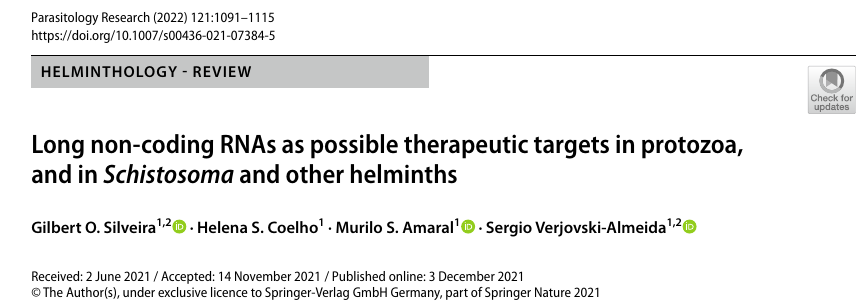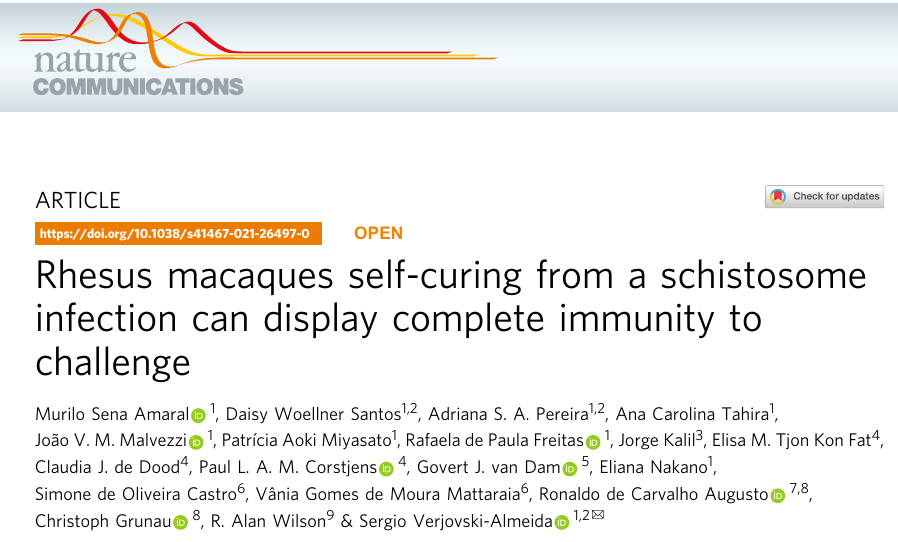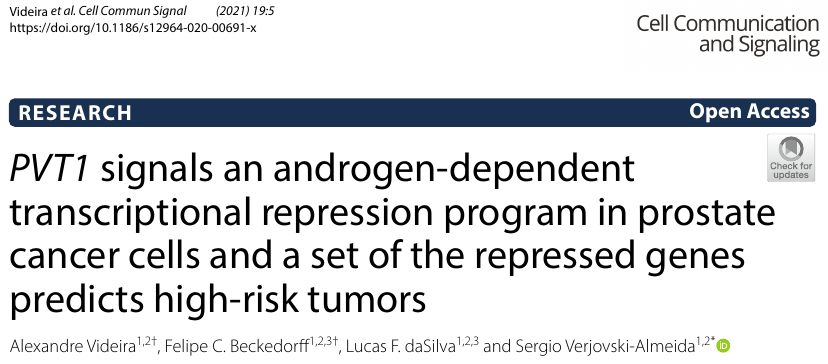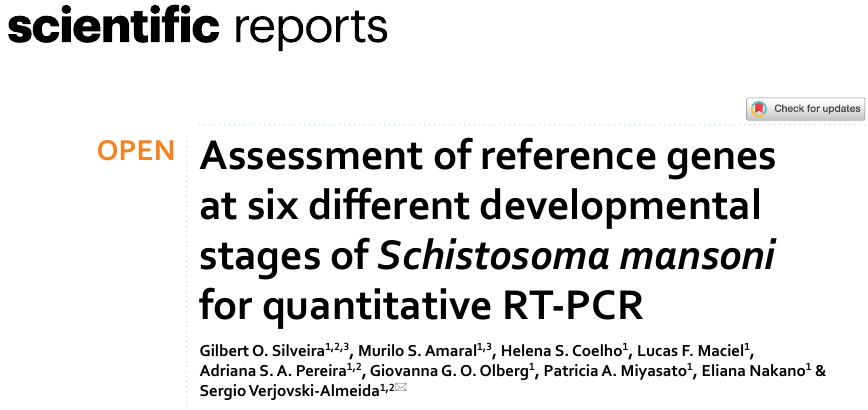Welcome to the main page of the Laboratory of Gene Expression in Eukaryotes headed by Prof. Sergio Verjovski-Almeida. Our lab is located in a beautiful sunny city São Paulo, Brazil. We study the large-scale gene expression profiles of human cells with the aim of identifying and characterizing the possible long non-coding RNA (lncRNA) regulators of gene expression programs in these cells. Cell biology approaches are used to characterize the molecular mechanisms of gene expression regulation of a few selected lncRNAs in human cells. We also study large-scale gene expression changes in the parasite Schistosoma mansoni, with a present focus on the effect of histone modifying enzyme inhibitors. Look below to find out more about us, our research, open positions and publications.

Media:
COVID19 Divulgação Científica
FAPESP Jornal da USP
EureKAlerts! Galileu
O Dia O Globo Folha de São Paulo
Background. 2004-2008. Our project entitled ″Identification of molecular markers for diagnosis and prognosis in cancer using DNA microarrays″, has identified dozens of intronic non-coding anti-sense RNAs (ncRNAs) whose expression levels were correlated to the degree of malignancy of prostate tumors (Reis et al., 2004; PMID: 15221013). This discovery has an impact on the molecular diagnosis of cancer in general, arguing for inclusion of non-coding RNAs, both intra- and inter-genic, into the arsenal of tools used for molecular diagnostics, so far almost exclusively populated by exonic protein-coding RNAs.
In our project we have also identified that:
- the expression profiles of intronic ncRNAs in normal human liver and kidney tissues and in prostate tumors, using customized microarrays with nearly 30 thousand probes for non-coding intronic RNAs. It was observed that the most abundant intronic ncRNAs are transcribed from genomic loci involved with regulation of transcription, in all three tissues studied (Nakaya et al., 2007; PMID: 17386095);
- that the expression of a number of intronic ncRNAs could be modulated by androgen in a prostate cancer cell line, and that androgen modulates both the expression level of certain ncRNAs and the use of alternatively spliced exons of protein-coding genes from the same genomic locus (Louro et al., 2007; PMID: 17263875);
- that a comparative analysis between human and mice intronic ncRNAs revealed a conserved tissue-specific expression profile, suggesting an evolutionarily conserved role of these transcripts among these species, probably involved in the fine tuning of gene expression in mammalian tissues (Louro et al., 2008; PMID: 18495418).
Current studies. In August 2008, our group received a new grant from FAPESP for the period 2008-2012. The current thematic project is titled ″Functional characterization of intronic non-coding RNAs expressed in the human genome″, a collaborative project between our group and the research group of Dr. Eduardo M. Reis, an Assistant Professor in our Department. The project aims to investigate the functional implications of intronic ncRNAs in cancer as well as in gene regulation in normal cells, along with their possible use as markers of malignancy in a number of cancers. The present project will permit to consolidate in our group the use of cell biology approaches for the study of ncRNAs, a line of work that has been recently introduced in our laboratory. Currently, our group is studying the effect of over-expression of selected ncRNAs on cell proliferation and cell invasion.
The project is divided into two major parts:
(A) Functional characterization of non-coding RNAs over-expressed in human tumors, and
(B) Identification of novel non-coding RNAs and validation of gene expression profiles as possible tumor markers.
We expect to identify genes that are possible new molecular markers of early diagnosis and prognosis in prostate cancer, as well as to elucidate some of the mechanisms of action of ncRNAs, contributing to broaden the potential targets for therapeutic interventions.
Publications
Back to the top
Schistosoma mansoni EST genome. Our group has received support from FAPESP to build DNA microarrays on glass-slides containing 4 000 S. mansoni gene fragments. See the project here. These were selected among the 14 000 genes that were identified by the S. mansoni EST Genome Project, coordinated by our group, whose results were published in Nature Genetics on October 1st, 2003 (download PDF; PMID: 12973350).
One of our first goals will be to use microarrays to do large-scale gene expression analysis in adult worms and to study the effect of hormones and cytokines. Gene expression pattern during S. mansoni development and maturation from cercaria to schistosomula will also be studied. Collaboration with other research groups worldwide is envisaged.
Schistosoma mansoni TNF-α receptor. We have recently described (Oliveira et al., 2009; PMID: 19956564) a possible TNF-α receptor (TNFR) homolog gene in S. mansoni (SmTNFR). SmTNFR encodes a complete receptor sequence composed of 599 amino acids, and contains four cysteine-rich domains as described for TNFR members.
Real-time RT-PCR experiments revealed that SmTNFR highest expression level is in cercariae, 3.5 (60.7) times higher than in adult worms. Downstream members of the known human TNF-α pathway were identified by an in silico analysis, revealing a possible TNF-α signaling pathway in the parasite. In order to simulate parasite's exposure to human cytokine during penetration of the skin, schistosomula were exposed to human TNF-α just 3 h after cercariae-to-schistosomula in vitro transformation, and large-scale gene expression measurements were performed with microarrays. A total of 548 genes with significantly altered expression were detected, when compared to control parasites. In addition, treatment of adult worms with TNF-α caused a significantly altered expression of 1857 genes. Interestingly, the set of genes altered in adults is different from that of schistosomula, with 58 genes in common, representing 3% of altered genes in adults and 11% in 3 h-old early schistosomula. The possible molecular elements and targets involved in human TNF-α effect on S. mansoni were described, highlighting the mechanism by which recently transformed schistosomula may sense and respond to this host mediator at the site of cercarial penetration into the skin.
Our present work aims at further characterizing the receptor by its immuno-localization at different organs of the parasite, by searching for possible partner protein ligands with the use of two-hybrid systems, by looking for the possible effect of siRNA of the receptor message on parasite survival in the model host.
Publications
Back to the top
Our group developed competence in bioinformatics to support the large scale transcriptome sequencing and analyses projects of both humans and S. mansoni. Our team of bioinformaticians is composed of technicians with higher degree in computer sciences and graduate students in bioinformatics. They work in the large scale mapping of all human ESTs in the genome, in order to select transcribed genes of interest to be selected as probes for the construction of dedicated microarrays. These are used in our large scale gene expression studies.
Click here to see the Bioinformatics webpage of the group.
Back to the top

Principal investigator
Sergio Verjovski-Almeida, PhD, MD
Scientific Leadership at Butantan
Senior Full Professor at USP
Av. Vital Brasil 1500, Predio 55
05503-900 São Paulo, SP, Brasil
e-mail 1: verjo (at) iq.usp.br
e-mail 2: sergio.verjovski (at) butantan.gov.br
phone: +55-11-2627-3850 (my office)
phone: +55-11-2627-3855 (laboratory)
Researchers:
- Murilo Sena Amaral, PhD
- Ana Carolina Tahira, PhD
Postdoctoral researchers:
- Maria Gabriela Berzoti Coelho, PhD
PhD and Master students:
- Daisy Woellner Santos
- Thalles Souza Lopes
- Fabio Nunes de Mello
- Raquel Silveira de Oliveira
- Ágatha Fischer Machado
- Kayque Lucas Silva Correia Lima
- Pedro Jardim Poli
- Jose Arthur Souza Barbosa
Technical Assistant for Scientific Research:
- Tereza Cristina Barbosa
Technical Support:
- Carlos Renato Nascimento
Secretary:
- Ana Paula Lopes Vidal
spacer
- murilo.amaral@butantan.gov.br
- ana.tahira@butnatan.gov.br
spacer
- gabrielaberzoti@gmail.com
spacer
- daisywsantos@usp.br
- thalles.lopes.esib@esib.butantan.gov.br
- fabio.mello.esib@esib.butantan.gov.br
spacer
- r983184847@usp.br
- fischeragatha@usp.br
- kayquelucas4@usp.br
- pedropoli23@usp.br
- jarthursouza.jasb@gmail.com
spacer
spacer
- tereza.barbosa@butantan.gov.br
spacer
spacer
spacer
- ana.vidal@butantan.gov.br
spacer
spacer

Positions open for undergraduate or graduate work.
E-mail your CV to verjo (at) iq.usp.br or call by phone for additional information.
Estágio de Iniciação Científica ou Pós-graduação disponível.
Mande seu CV para verjo (at) iq.usp.br ou telefone para obter mais informações.
PVT1 signals an androgen-dependent transcriptional repression program in prostate cancer cells and a set of the repressed genes predicts high-risk tumors
Alexandre Videira, Felipe C. Beckedorff, Lucas F. daSilva and Sergio Verjovski-Almeida
Cell Commun Signal. 2021; 19: 5. doi: 10.1186/s12964-020-00691-x.
Chromatin landscape distinguishes the genomic loci of hundreds of androgen-receptor-associated lincRNAs from the loci of non-associated lincRNAs.
daSilva LF, Beckedorff FC, Ayupe AC, Amaral MS, Mesel V, Videira A, Reis EM, Setubal JC, Verjovski-Almeida S.
Front. Genet. 2018 9:132. doi: 10.3389/fgene.2018.00132.
Discordant congenital Zika syndrome twins show differential in vitro viral susceptibility of neural progenitor cells.
Caires-Júnior LC, Goulart E, Melo US, Araujo BHS, other 34 authors, Verjovski-Almeida S, Ho PL, Passos-Bueno MR & Zatz M.
Nat. Comm. 2018 9:475. doi: 10.1038/s41467-017-02790-9. PMID: 29396410
Media:
Jornal da USP
FAPESP
JR 24hs
Vulnerability of primitive human placental trophoblast to Zika virus.
Sheridan MA, Yunusov D, Balaraman V, Alexenko AP, Yabe S, Verjovski-Almeida S, Schust DJ, Franz AW, Sadovsky Y, Ezashi T, Roberts RM.
Proc Natl Acad Sci U S A. 2017 Feb 28;114(9):E1587-E1596. doi: 10.1073/pnas.1616097114. PMID: 28193876
HIPSTR and thousands of lncRNAs are heterogeneously expressed in human embryos, primordial germ cells and stable cell lines.
Yunusov D, Anderson L, DaSilva LF, Wysocka J, Ezashi T, Roberts RM, Verjovski-Almeida S.
Sci Rep. 2016 Sep 8;6:32753. doi: 10.1038/srep32753. PMID: 27605307
Identification of novel biomarkers associated with poor patient outcomes in invasive breast carcinoma.
Canevari RA, Marchi FA, Domingues MA, de Andrade VP, Caldeira JR, Verjovski-Almeida S, Rogatto SR, Reis EM.
Tumour Biol. 2016 Aug 2. PMID: 27485113
Jagged 1 Rescues the Duchenne Muscular Dystrophy Phenotype.
Vieira NM, Elvers I, Alexander MS, Moreira YB, Eran A, Gomes JP, Marshall JL, Karlsson EK, Verjovski-Almeida S, Lindblad-Toh K, Kunkel LM,
Zatz M.
Cell. 2015 Nov 19; 163(5):1204-13. PMID: 26582133
Global analysis of biogenesis, stability and sub-cellular localization of lncRNAs mapping to intragenic regions of the human genome.
Ayupe AC, Tahira AC, Camargo L, Beckedorff FC, Verjovski-Almeida S, Reis EM.
RNA Biol. 2015; 12(8):877-92. PMID: 26151857
Long non-coding RNA INXS is a critical mediator of BCL-XS induced apoptosis.
DeOcesano-Pereira C, Amaral MS, Parreira KS, Ayupe AC, Jacysyn JF, Amarante-Mendes GP, Reis EM, Verjovski-Almeida S.
Nucleic Acids Res. 2014 Sep 1; 42(13):8343-55. PMID: 27507889
Expression analysis and in silico characterization of intronic long noncoding RNAs in renal cell carcinoma: emerging functional associations.
Fachel AA, Tahira AC, Vilella-Arias SA, Maracaja-Coutinho V, Gimba ER, Vignal GM, Campos FS, Reis EM, Verjovski-Almeida S.
Mol Cancer. 2013 Nov 15; 12(1):140. PMID: 24238219
Long non-coding RNAs and their implications in cancer epigenetics.
Beckedorff FC, Amaral MS, Deocesano-Pereira C, Verjovski-Almeida S.
Biosci Rep. 2013 Aug 30; 33(4). Review. PMID: 23875687
The intronic long noncoding RNA ANRASSF1 recruits PRC2 to the RASSF1A promoter, reducing the expression of RASSF1A and increasing cell proliferation.
Beckedorff FC, Ayupe AC, Crocci-Souza R, Amaral MS, Nakaya HI, Soltys DT, Menck CF, Reis EM, Verjovski-Almeida S.
PLoS Genet. 2013; 9(8):e1003705. Epub 2013 Aug 22. PMID: 23990798
Non-coding transcription characterization and annotation: a guide and web resource for non-coding RNA databases.
Paschoal AR, Maracaja-Coutinho V, Setubal JC, Simões ZL, Verjovski-Almeida S, Durham AM.
RNA Biol. 2012 Mar; 9(3):274-82. Review. PMID: 22336709
Long noncoding intronic RNAs are differentially expressed in primary and metastatic pancreatic cancer.
Tahira AC, Kubrusly MS, Faria MF, Dazzani B, Fonseca RS, Maracaja-Coutinho V, Verjovski-Almeida S, Machado MC, Reis EM.
Mol Cancer. 2011 Nov 13; 10:141. PMID: 22078386
Long intronic noncoding RNA transcription: expression noise or expression choice?
Louro R, Smirnova AS, Verjovski-Almeida S.
Genomics. 2009 Apr; 93(4):291-8. Review. PMID: 19071207
Gene expression profiling reveals molecular marker candidates of laryngeal squamous cell carcinoma.
Colombo J, Fachel AA, De Freitas Calmon M, Cury PM, Fukuyama EE, Tajara EH, Cordeiro JA, Verjovski-Almeida S, Reis EM, Rahal P.
Oncol Rep. 2009 Mar; 21(3):649-63. PMID: 19212623
Identification of protein-coding and intronic noncoding RNAs down-regulated in clear cell renal carcinoma.
Brito GC, Fachel AA, Vettore AL, Vignal GM, Gimba ER, Campos FS, Barcinski MA, Verjovski-Almeida S, Reis EM.
Mol Carcinog. 2008 Oct; 47(10):757-67. PMID: 18348187
Splice variants of TLE family genes and up-regulation of a TLE3 isoform in prostate tumors.
Nakaya HI, Beckedorff FC, Baldini ML, Fachel AA, Reis EM, Verjovski-Almeida S.
Biochem Biophys Res Commun. 2007 Dec 28; 364(4):918-23. PMID: 18273443
Genome mapping and expression analyses of human intronic noncoding RNAs reveal tissue-specific patterns and enrichment in genes related to regulation of transcription.
Nakaya HI, Amaral PP, Louro R, Lopes A, Fachel AA, Moreira YB, El-Jundi TA, da Silva AM, Reis EM, Verjovski-Almeida S.
Genome Biol. 2007; 8(3):R43. PMID: 17386095
Androgen responsive intronic non-coding RNAs.
Louro R, Nakaya HI, Amaral PP, Festa F, Sogayar MC, da Silva AM, Verjovski-Almeida S, Reis EM.
BMC Biol. 2007 Jan 30; 5:4. PMID: 17263875
Evaluation of reference-based two-color methods for measurement of gene expression ratios using spotted cDNA microarrays.
Peixoto BR, Vêncio RZ, Egidio CM, Mota-Vieira L, Verjovski-Almeida S, Reis EM.
BMC Genomics. 2006 Feb 24; 7:35. PMID: 16504121
Gene expression arrays in cancer research: methods and applications.
Brentani RR, Carraro DM, Verjovski-Almeida S, Reis EM, Neves EJ, de Souza SJ, Carvalho AF, Brentani H, Reis LF.
Crit Rev Oncol Hematol. 2005 May; 54(2):95-105. Review. PMID: 15843092
As antisense RNA gets intronic.
Reis EM, Louro R, Nakaya HI, Verjovski-Almeida S.
OMICS. 2005 Spring; 9(1):2-12. Review. PMID: 15805775
Antisense intronic non-coding RNA levels correlate to the degree of tumor differentiation in prostate cancer.
Reis EM, Nakaya HI, Louro R, Canavez FC, Flatschart AV, Almeida GT, Egidio CM, Paquola AC, Machado AA, Festa F, Yamamoto D, Alvarenga R, da Silva CC, Brito GC, Simon SD, Moreira-Filho CA, Leite KR, Camara-Lopes LH, Campos FS, Gimba E, Vignal GM, El-Dorry H, Sogayar MC, Barcinski MA, da Silva AM, Verjovski-Almeida S.
Oncogene. 2004 Aug 26; 23(39):6684-92. PMID: 15221013
More publications in Prof. Sergio Verjovski-Almeida's CV
Back to the top
Rhesus macaques self-curing from a schistosome infection can display complete immunity to challenge
Murilo Sena Amaral, Daisy Woellner Santos, Adriana S. A. Pereira, Ana Carolina Tahira, João V. M. Malvezzi, Patrícia Aoki Miyasato, Rafaela de Paula Freitas, Jorge Kalil, Elisa M. Tjon Kon Fat, Claudia J. de Dood, Paul L. A. M. Corstjens, Govert J. van Dam, Eliana Nakano, Simone de Oliveira Castro, Vânia Gomes de Moura Mattaraia, Ronaldo de Carvalho Augusto, Christoph Grunau, R. Alan Wilson and Sergio Verjovski-Almeida
Nat Commun 12, 6181 (2021).doi: https://doi.org/10.1038/s41467-021-26497-0
Assessment of reference genes at six different developmental stages of Schistosoma mansoni for quantitative RT-PCR
Gilbert O Silveira, Murilo S Amaral, Helena S Coelho, Lucas F Maciel, Adriana S A Pereira, Giovanna G O Olberg, Patricia A Miyasato, Eliana Nakano, Sergio Verjovski-Almeida
Scientific Reports volume 11, Article number: 16816 2021.doi: https://doi.org/10.1038/s41598-021-96055-7
Long non-coding RNA levels can be modulated by 5-Azacytidine in Schistosoma mansoni
Murilo S. Amaral, Lucas F. Maciel, Gilbert O. Silveira, Giovanna G. O. Olberg, João V. P. Leite, Lucas K. Imamura, Adriana S. A. Pereira, Patricia A. Miyasato, Eliana Nakano and Sergio Verjovski-Almeida
Scientific Reports 10:21565 2020.doi: https://doi.org/10.1038/s41598-020-78669-5
Dynamic Expression of Long Non-Coding RNAs Throughout Parasite Sexual and Neural Maturation in Schistosoma japonicum
Lucas F. Maciel, David A. Morales-Vicente and Sergio Verjovski-Almeida.
Non-coding RNA 6(2):15 2020. doi: https://doi.org/10.3390/ncrna6020015
Weighted Gene Co-Expression Analyses Point to Long Non-Coding RNA Hub Genes at Different Schistosoma mansoni Life-Cycle Stages
Lucas F. Maciel, David A. Morales-Vicente, Gilbert O. Silveira, Raphael O. Ribeiro, Giovanna G. O. Olberg, David S. Pires, Murilo S. Amaral and Sergio Verjovski-Almeida
Front. Genet., 12 September 2019. doi: https://doi.org/10.3389/fgene.2019.00823
Inhibition of histone methyltransferase EZH2 in Schistosoma mansoni in vitro by GSK343 reduces egg laying and decreases the expression of genes implicated in DNA replication and noncoding RNA metabolism.
Adriana S.A. Pereira, Murilo S. Amaral, Elton J.R. Vasconcelos, David S. Pires, Huma Asif, Lucas F. daSilva, David A. Morales-Vicente, Vitor C. Carneiro, Claudia B. Angeli, Giuseppe Palmisano, Marcelo R. Fantappie, Raymond J. Pierce, Joao C. Setubal, Sergio Verjovski-Almeida.
PLoS Negl Trop Dis. 2018; 12:e0006873. doi: 10.1371/journal.pntd.0006873
Atlas of Schistosoma mansoni long non-coding RNAs and their expression correlation to protein-coding genes.
Vasconcelos EJR, Mesel VC, daSilva LF, Pires DS, Lavezzo GM, Pereira ASA, Amaral MS, Verjovski-Almeida S.
Database. 2018 Jan 1; 2018:bay068. doi: 10.1093/database/bay068. PMID: 29992321
The Schistosoma mansoni genome encodes thousands of long non-coding RNAs predicted to be functional at different parasite life-cycle stages.
Vasconcelos EJR, daSilva LF, Pires DS, Lavezzo GM, Pereira ASA, Amaral MS, Verjovski-Almeida S.
Sci Rep. 2017 Sep 5;7(1):10508. doi: 10.1038/s41598-017-10853-6. PMID: 28874839
Histone deacetylase inhibition modulates histone acetylation at gene promoter regions and affects genome-wide gene transcription in Schistosoma mansoni.
Anderson L, Gomes MR, daSilva LF, Pereira AD, Mourão MM, Romier C, Pierce R, Verjovski-Almeida S.
PLoS Negl Trop Dis. 2017 Apr 13;11(4):e0005539. doi: 10.1371/journal.pntd.0005539. PMID: 28406899
Interaction of an esophageal MEG protein from schistosomes with a human S100 protein involved in inflammatory response.
Orcia D, Zeraik AE, Lopes JL, Macedo JN, Santos CR, Oliveira KC, Anderson L, Wallace BA, Verjovski-Almeida S, Araujo AP, DeMarco R.
Biochim Biophys Acta. 2016 Sep 15. doi: 10.1016/j.bbagen.2016.09.015. PMID: 27639541
Human TNF-α induces differential protein phosphorylation in Schistosoma mansoni adult male worms.
Oliveira KC, Carvalho ML, Bonatto JM, Schechtman D, Verjovski-Almeida S.
Parasitol Res. 2016 Feb; 115(2):817-28. PMID: 26547565
Schistosoma mansoni Egg, Adult Male and Female Comparative Gene Expression Analysis and Identification of Novel Genes by RNA-Seq.
Anderson L, Amaral MS, Beckedorff F, Silva LF, Dazzani B, Oliveira KC, Almeida GT, Gomes MR, Pires DS, Setubal JC, DeMarco R, Verjovski-Almeida S.
PLoS Negl Trop Dis. 2015 Dec 31; 9(12):e0004334. PMID: 26719891
Synergy of Omeprazole and Praziquantel in vitro Treatment against Schistosoma mansoni Adult Worms.
Almeida GT, Lage RC, Anderson L, Venancio TM, Nakaya HI, Miyasato PA, Rofatto HK, Zerlotini A, Nakano E, Oliveira G, Verjovski-Almeida S.
PLoS Negl Trop Dis. 2015 Sep 24; 9(9):e0004086. PMID: 26402251
Exploring the Schistosoma mansoni adult male transcriptome using RNA-seq.
Almeida GT, Amaral MS, Beckedorff FC, Kitajima JP, DeMarco R, Verjovski-Almeida S.
Exp Parasitol. 2012 Sep; 132(1):22-31. PMID: 21745473
Effect of human TGF-β on the gene expression profile of Schistosoma mansoni adult worms.
Oliveira KC, Carvalho ML, Verjovski-Almeida S, LoVerde PT.
Mol Biochem Parasitol. 2012 Jun; 183(2):132-9. PMID: 22387759
Schistosoma mansoni histones: From transcription to chromatin regulation; an in silico analysis.
Anderson L, Pierce RJ, Verjovski-Almeida S.
Mol Biochem Parasitol. 2012 Jun; 183(2):105-14. Review. PMID: 22414701
Protein variation in blood-dwelling schistosome worms generated by differential splicing of micro-exon gene transcripts.
DeMarco R, Mathieson W, Manuel SJ, Dillon GP, Curwen RS, Ashton PD, Ivens AC, Berriman M, Verjovski-Almeida S, Wilson RA.
Genome Res. 2010 Aug; 20(8):1112-21. PMID: 20606017
Bursts of transposition from non-long terminal repeat retrotransposon families of the RTE clade in Schistosoma mansoni.
Venancio TM, Wilson RA, Verjovski-Almeida S, DeMarco R.
Int J Parasitol. 2010 May; 40(6):743-9. PMID: 20018191
Identification of the Schistosoma mansoni TNF-alpha receptor gene and the effect of human TNF-alpha on the parasite gene expression profile.
Oliveira KC, Carvalho ML, Venancio TM, Miyasato PA, Kawano T, DeMarco R, Verjovski-Almeida S.
PLoS Negl Trop Dis. 2009 Dec 1; 3(12):e556. PMID: 19956564
Analysis of Schistosoma mansoni genes shared with Deuterostomia and with possible roles in host interactions.
Venancio TM, DeMarco R, Almeida GT, Oliveira KC, Setubal JC, Verjovski-Almeida S.
BMC Genomics. 2007 Nov 8; 8:407. PMID: 17996068
A quantitative view of the transcriptome of Schistosoma mansoni adult-worms using SAGE.
Ojopi EP, Oliveira PS, Nunes DN, Paquola A, DeMarco R, Gregorio SP, Aires KA, Menck CF, Leite LC, Verjovski-Almeida S, Dias-Neto E.
BMC Genomics. 2007 Jun 21; 8:186. PMID: 17584941
Use of a 44k oligoarray to explore the transcriptome of Schistosoma mansoni adult worms.
Verjovski-Almeida S, Venancio TM, Oliveira KC, Almeida GT, DeMarco R.
Exp Parasitol. 2007 Nov; 117(3):236-45. PMID: 17517391
SmTRC1, a novel Schistosoma mansoni DNA transposon, discloses new families of animal and fungi transposons belonging to the CACTA superfamily.
DeMarco R, Venancio TM, Verjovski-Almeida S.
BMC Evol Biol. 2006 Nov 7; 6:89. PMID: 17090310
Gender biased differential alternative splicing patterns of the transcriptional cofactor CA150 gene in Schistosoma mansoni.
DeMarco R, Oliveira KC, Venancio TM, Verjovski-Almeida S.
Mol Biochem Parasitol. 2006 Dec; 150(2):123-31. PMID: 16904200
Identification of 18 new transcribed retrotransposons in Schistosoma mansoni.
DeMarco R, Machado AA, Bisson-Filho AW, Verjovski-Almeida S.
Biochem Biophys Res Commun. 2005 Jul 22; 333(1):230-40. PMID: 15939396
Schistosome transcriptome: insights and perspectives for functional genomics.
Verjovski-Almeida S, Leite LC, Dias-Neto E, Menck CF, Wilson RA.
Trends Parasitol. 2004 Jul; 20(7):304-8. Review. PMID: 15193558
Saci-1, -2, and -3 and Perere, four novel retrotransposons with high transcriptional activities from the human parasite Schistosoma mansoni.
DeMarco R, Kowaltowski AT, Machado AA, Soares MB, Gargioni C, Kawano T, Rodrigues V, Madeira AM, Wilson RA, Menck CF, Setubal JC, Dias-Neto E, Leite LC, Verjovski-Almeida S.
J Virol. 2004 Mar; 78(6):2967-78. Erratum in: J Virol. 2004 May; 78(9):4950. PMID: 14990715
Transcriptome analysis of the acoelomate human parasite Schistosoma mansoni.
Verjovski-Almeida S, DeMarco R, Martins EA, Guimaraes PE, Ojopi EP, Paquola AC, Piazza JP, Nishiyama MY Jr, Kitajima JP, Adamson RE, Ashton PD, Bonaldo MF, Coulson PS, Dillon GP, Farias LP, Gregorio SP, Ho PL, Leite RA, Malaquias LC, Marques RC, Miyasato PA, Nascimento AL, Ohlweiler FP, Reis EM, Ribeiro MA, Sa RG, Stukart GC, Soares MB, Gargioni C, Kawano T, Rodrigues V, Madeira AM, Wilson RA, Menck CF, Setubal JC, Leite LC, Dias-Neto E.
Nat Genet. 2003 Oct; 35(2):148-57. PMID: 12973350
More publications in Prof. Sergio Verjovski-Almeida's CV
Back to the top
Lab on the map
About São Paulo:
Founded: January 25, 1554
Area: 1,522.986 km²
Population: 11 037 593
Official website of the city
Official tourism site
Weather forecast
Buses and metrô
Wikipedia about São Paulo
In the section below we share our collection of the links that are used almost daily by researchers of our group.
Verjolab Resources
S. mansoni
Genome Browser at USP iCloud
Other Genome Resources
Databases
UCSC Genome Browser
ArrayExpress Archive
SRA Database
The Human Protein Atlas
UniProt
GeneCards V3
SmLINCs DB
JASPAR Database
RBPDB
S. mansoni
on GeneDB
S. mansoni
WormBase ParaSite
GO enrichment analysis
Metascape
Enrichr
AmiGO
DAVID
GATHER
Cell banks
ATCC
DSMZ
CLS
Rio de Janeiro Cell Bank
Tools for every day
Synergizer
Reverse Complement
RNAfold webserver
RNAz webserver
catRAPID
NEBcutter V2.0
Primer3
IDT OligoAnalyzer
BLOCK-iT™ RNAi Designer
Optimized CRISPR Design
Genome Engineering Tools
QUMA
CPC
CPAT
ORF Finder
HCpolya
SciNote Electronic Lab Notebook
NCBI tools
PubMed
BLAST
Primer-BLAST
AceView
List of all NCBI resources
Publishers
Nature Publishing Group
AAAS Science Journals
Oxford University Press
HighWire Press
CSHL Press
BioMed Central
Springer (Life Sciences)
Elsevier (Life Sciences)
PLoS
Other links
ISI web of knowledge
Google Scholar
CrossRef














 CV Lattes
CV Lattes Profile at ResearcherID.com
Profile at ResearcherID.com orcid.org/0000-0002-6356-2401
orcid.org/0000-0002-6356-2401 Google Scholar Citations
Google Scholar Citations